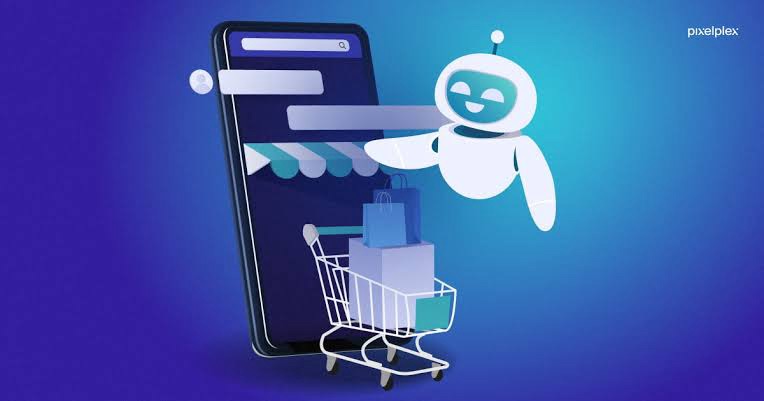How AI is Revolutionizing E-Commerce: Trends, Benefits, and Future Impact

Artificial Intelligence (AI) is transforming the landscape of e-commerce, bringing significant changes to how businesses operate and how consumers shop online. From personalized shopping experiences to enhanced customer service, AI is helping e-commerce platforms to become smarter, more efficient, and more responsive to the needs of their customers. In this blog post, we’ll explore how AI is revolutionizing e-commerce and shaping the future of online shopping.
1. Personalized Shopping Experiences
One of the most significant impacts of AI on e-commerce is its ability to create highly personalized shopping experiences. AI algorithms analyze vast amounts of customer data, including browsing history, purchase patterns, and even social media activity, to offer personalized recommendations tailored to individual preferences.
a. Product Recommendations
AI-powered recommendation engines are now a staple of e-commerce platforms like Amazon, Netflix, and Spotify. These engines analyze user data to suggest products, movies, or songs that align with the customer’s tastes, increasing the likelihood of purchase and improving customer satisfaction.
b. Dynamic Pricing
AI also enables dynamic pricing, where prices are adjusted in real-time based on factors such as demand, competition, and customer behavior. This approach allows e-commerce businesses to optimize their pricing strategies, ensuring they remain competitive while maximizing profits.
c. Customized Marketing
AI-driven marketing tools can segment customers based on their preferences and behaviors, allowing businesses to deliver targeted advertisements and promotions. This personalization increases the effectiveness of marketing campaigns, leading to higher conversion rates and customer loyalty.
2. Enhanced Customer Service
AI is revolutionizing customer service in e-commerce by providing faster, more accurate, and more efficient support. AI-powered tools, such as chatbots and virtual assistants, are increasingly being used to handle customer inquiries, process orders, and resolve issues.
a. Chatbots
AI chatbots can engage with customers in real-time, answering questions, guiding them through the shopping process, and even helping with post-purchase support. These chatbots are available 24/7, providing immediate assistance and improving the overall customer experience.
b. Virtual Assistants
Virtual assistants, like Amazon’s Alexa or Google Assistant, allow customers to shop using voice commands, making the shopping experience more convenient and accessible. These assistants can also help customers track orders, find product information, and manage their shopping lists.
c. Sentiment Analysis
AI tools can analyze customer feedback and reviews to gauge sentiment and identify areas for improvement. By understanding how customers feel about products and services, businesses can make data-driven decisions to enhance their offerings and address any issues.
3. Inventory Management and Supply Chain Optimization
AI is transforming e-commerce operations by optimizing inventory management and streamlining supply chains. These advancements ensure that businesses can meet customer demand while minimizing costs and reducing waste.
a. Demand Forecasting
AI algorithms can analyze historical sales data, market trends, and external factors (such as weather or economic conditions) to predict future demand for products. Accurate demand forecasting helps businesses maintain optimal inventory levels, reducing the risk of stockouts or overstocking.
b. Automated Warehousing
AI-powered robots and automation systems are revolutionizing warehouse operations, making them more efficient and reducing the need for manual labor. These systems can manage inventory, pick and pack orders, and even perform quality control checks, speeding up the fulfillment process.
c. Supply Chain Optimization
AI can optimize supply chains by identifying the most efficient routes for shipping, predicting potential disruptions, and automating order processing. This optimization reduces costs, improves delivery times, and ensures that products reach customers quickly and reliably.
4. Fraud Detection and Prevention
As e-commerce grows, so does the risk of fraud. AI is playing a crucial role in detecting and preventing fraudulent activities, protecting both businesses and customers from potential threats.
a. Real-Time Fraud Detection
AI algorithms can analyze transaction data in real-time to identify suspicious activity, such as unusual purchase patterns or unauthorized account access. By detecting potential fraud early, businesses can take immediate action to prevent financial losses and protect customer data.
b. Secure Payment Processing
AI is also enhancing the security of payment processing by using machine learning models to identify and block fraudulent transactions. These models can adapt to new threats, ensuring that payment systems remain secure and resilient against evolving fraud tactics.
c. Identity Verification
AI-powered identity verification tools can authenticate customers during the checkout process, reducing the risk of identity theft and ensuring that only legitimate users can complete transactions. This added layer of security enhances trust and confidence in e-commerce platforms.
5. Visual Search and Shopping
AI is making online shopping more intuitive and accessible through the development of visual search technologies. These tools allow customers to search for products using images rather than text, making it easier to find exactly what they’re looking for.
a. Visual Search Engines
Visual search engines, like those used by Pinterest and Google, enable customers to upload images or take photos of products they’re interested in. The AI algorithms then analyze the image and return matching or similar products available for purchase, simplifying the shopping process.
b. Augmented Reality (AR) Shopping
AI-driven AR tools are transforming how customers shop online, particularly in sectors like fashion and home decor. AR allows customers to virtually “try on” clothes, accessories, or even visualize how furniture would look in their homes, enhancing the online shopping experience and reducing the likelihood of returns.
6. Predictive Analytics and Business Insights
AI is providing e-commerce businesses with powerful predictive analytics and insights that drive strategic decision-making and long-term growth.
a. Customer Behavior Analysis
AI can analyze vast amounts of data to predict customer behavior, such as when a customer is likely to make a purchase, what products they’re interested in, or when they might churn. These insights enable businesses to take proactive steps, such as sending personalized offers or improving customer retention strategies.
b. Sales Forecasting
AI-driven sales forecasting tools can predict future sales trends, helping businesses plan their inventory, marketing, and staffing needs. Accurate forecasting enables better resource allocation and ensures that businesses can meet customer demand without overextending themselves.
c. Market Trend Analysis
AI can also analyze market trends and consumer sentiment, providing businesses with insights into emerging trends and customer preferences. These insights help businesses stay ahead of the competition by identifying new opportunities and adapting their strategies accordingly.
7. The Future of AI in E-commerce
As AI continues to evolve, its role in e-commerce will only grow, with new innovations and applications on the horizon. Some of the future trends in AI-powered e-commerce include:
a. Hyper-Personalization
AI will continue to refine personalization, offering even more tailored shopping experiences based on real-time data and customer interactions. This hyper-personalization will extend to every aspect of the shopping journey, from product recommendations to dynamic pricing.
b. AI-Powered Customer Experiences
AI will drive the development of more immersive and interactive customer experiences, such as virtual shopping assistants, AI-generated product descriptions, and personalized content marketing. These advancements will make online shopping more engaging and enjoyable for customers.
c. Autonomous Delivery
AI and robotics will play a crucial role in the future of autonomous delivery, with drones, self-driving vehicles, and robotic couriers becoming more common in e-commerce logistics. These technologies will reduce delivery times, lower costs, and improve efficiency.
Conclusion
Artificial Intelligence is revolutionizing e-commerce in ways that were unimaginable just a few years ago. From personalized shopping experiences and enhanced customer service to optimized supply chains and fraud prevention, AI is helping e-commerce businesses operate more efficiently and serve their customers better. As AI technology continues to advance, we can expect even more innovative applications that will further transform the e-commerce landscape, making online shopping faster, safer, and more personalized than ever before. Businesses that embrace AI will be well-positioned to thrive in this rapidly evolving industry, while those that lag behind risk being left behind in the digital revolution.








 Total views : 6191
Total views : 6191